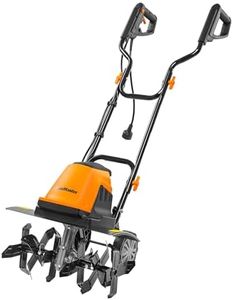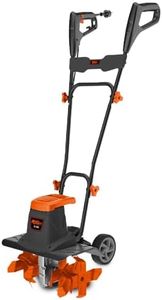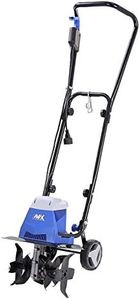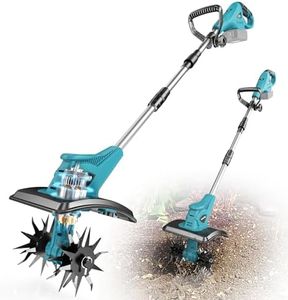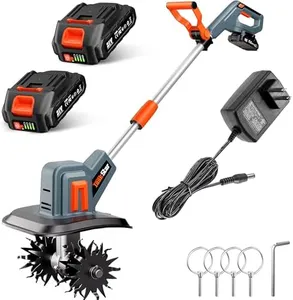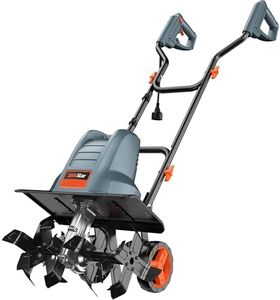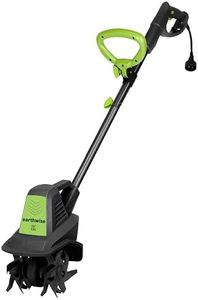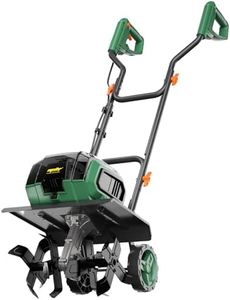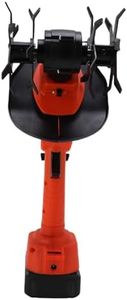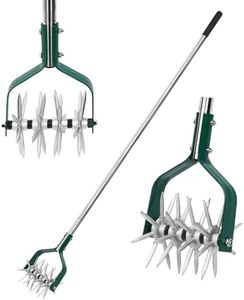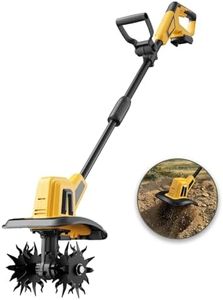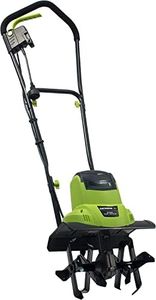We Use CookiesWe use cookies to enhance the security, performance,
functionality and for analytical and promotional activities. By continuing to browse this site you
are agreeing to our privacy policy
10 Best Electric Tillers
From leading brands and best sellers available on the web.Buying Guide for the Best Electric Tillers
Choosing the right electric tiller can make garden preparation much easier and more effective. An electric tiller helps you break up soil, mix in compost, and get your garden bed ready for planting. Since gardens can vary in size, soil type, and how much effort you want to put in, it's important to understand the key features that affect how a tiller will work for you. Think about the space you need to till, how tough your soil is, and how comfortable you want the experience to be. Being clear about your needs will help you pick a tiller that does the job without being unnecessarily complicated or heavy.Tilling WidthTilling width refers to how wide a section of soil the tiller can work in a single pass. This is important because it affects both how quickly you can prepare your garden bed and how maneuverable the tiller will be. Wider tillers (16 inches or more) are best for large, open areas because they cover more ground quickly, but they might be bulky in tight spaces. Medium widths (10–15 inches) offer a good balance for typical garden beds. Narrow tillers (8 inches or less) are great for small plots or working around established plants. To pick the right width, consider how much space you need to till and whether you need to navigate around obstacles or rows.
Tilling DepthTilling depth is the maximum depth the machine can dig into the soil in one go. This is important because deeper tilling is needed for planting root vegetables or for creating new beds, while shallow tilling may suffice for refreshing existing beds or mixing compost. Most tillers offer adjustable depth, usually ranging from a few inches up to 8 inches or more. Shallow settings (2–4 inches) are easier to control and good for maintenance, while deeper settings (6–8 inches) are for more intensive soil work. Choose a tiller that can reach the depth your gardening projects require.
Motor PowerElectric tillers are rated by motor power, often measured in amps. This tells you how much energy the motor can use to break up soil. More power is important for tougher soils like clay, larger gardens, or for breaking new ground. Entry-level tillers may have motors around 5–7 amps, suitable for smaller, softer beds. Mid-range models (8–10 amps) can handle medium-sized gardens with moderate soil. The highest power (12 amps or more) gives more force for large or challenging plots. Match power to how hard your soil is and how much area you plan to till.
Weight and HandlingThe weight of the tiller affects how easy it is to push, lift, and maneuver. Lighter models (under 25 pounds) are easy to carry and use for quick tasks or in tight spots, but may not dig as deeply or handle hard soil well. Heavier models (30 pounds and up) stay more stable while working but require more effort to move around, especially for extended periods. Think about your physical comfort and strength, and whether you need to carry the tiller to different parts of your yard.
Corded vs CordlessElectric tillers come in both corded and cordless designs. Corded models plug into an outlet, usually giving consistent power and the ability to work as long as needed, but you’ll need an appropriate extension cord and outlet access. Cordless tillers run on rechargeable batteries, offering more freedom of movement and no cord management, but limited by battery life and slightly less power. Pick corded if you have easy outlet access and larger areas to cover, or cordless if you need to move freely or till small, accessible spots.
Tine DesignTines are the blades that dig into the soil, and their shape and orientation affect how the tiller works. Most have forward-rotating tines (spinning in the same direction as you push) for easy soil mixing and general use. Some offer counter-rotating or dual-rotation tines, which can dig deeper or handle tougher soil. Longer, sharper tines dig deeper and faster, but may be harder to control. For most typical gardens, standard forward tines are sufficient. Consider specialized designs if your soil is particularly hard or if you plan on doing a lot of deep tilling.
